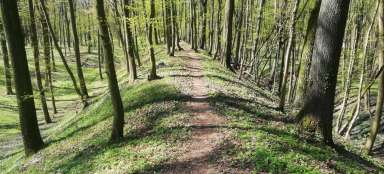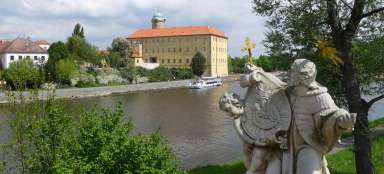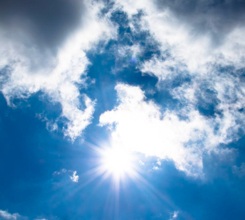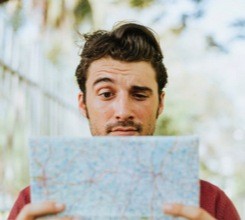How to get food in the wild
How to survive in nature 1 - how to get food

In this article, we will look at ways in which we can obtain some food for survival in an emergency, adjust it appropriately and extend its shelf life.
Hunger
The human body can withstand several weeks of starvation, but after only a few days without food, we begin to experience both signs of hunger and mental problems. The first thing that usually „takes us away“ in an emergency is our mental state. Feeling hungry does not add to our mental state. So how do you get food? We will take a closer look at this in this article.
Procurement of food
Tanzania's smallest national park
Procurement of food can be generally divided into two basic ways: Collection: We can collect plants, berries, fruits, as well as insects, insect larvae, eggs … Hunting: We can hunt small rodents, fish and larger animals … When procuring food, keep in mind that energy expenditure for collection or hunting should always be less than energy intake from food. It's nonsense to chase a small rodent for half a day and then have it out of your mouth twice. It is better to collect edible plants when looking for a route …
Rabble
Tanzania's smallest national park
Collection is the simplest and least energy-intensive way to procure food. Collection of edible plants: By consuming unknown plants, we are exposed to the risk of stomach problems and possible poisoning. It is always a good idea to check in advance what edible plants occur in our place of residence. We can also consume, for example, spruce, water lilies, forest fruits, mushrooms. The lower layer of spruce bark contains a lot of vitamin C. Water lilies are edible from top to bottom (seeds, tubers and stems), only water lily seeds are a little bitter … Plant edibility test: In emergency situations, most poisonous plants can be ruled out using a test. Exclude plants from which white juice flows immediately. The same goes for plants that smell like peaches or almonds. Gently rub the inside of the forearm with the test plant to see if it irritates the skin or causes a rash. Then test the reaction on the lips. If you do not feel tingling or burning on your lips, try placing the plant on the tip of your tongue for a few seconds. Then try to eat a piece of the plant and wait a few hours. If you do not experience nausea, diarrhea and other adverse reactions, the plant is probably edible. When I talked about collecting plants and fruits with the Amazon Indian and asked him if there was any way to recognize edible and inedible plants in the jungle, he started laughing. I didn't understand why he was laughing at me. Then he explained to me that it was clear, right? I still didn't understand. Then he explained, "Do you see the monkeys and see what they eat? We're actually monkeys, too, so you can easily eat what they do. They don't eat anything poisonous. Yeah, and if you see them pull away, back away too, because there's one coming. trouble … "How simple is that? Sometimes all you have to do is observe the surroundings … Collection of insects, larvae, eggs: In nature we can usually come across anthills, old trees, stumps, bird nests … All these things can mean food for us. We can find many ant larvae in the anthill. We can consume these larvae both raw and we can also roast them on the fire, after this treatment they taste almost like nuts :-). However, beware of some tropical species of ants, whose bites are very painful, and with a larger number of bites we may have more serious health problems. Under the bark of old trees and in old stumps, there are many different species of beetle larvae. The larvae are a very good source of energy, which we will certainly need afterwards. Beetles, as such, I recommend not consuming at all. Most of them excrete defensive substances that either smell disgusting and taste disgusting, or they can also excrete toxic substances (in our country, for example, Majka Fialová), which can cause us serious health problems, sometimes even death. Wasps and bees also taste great. But watch out for stings. If you find a wasp's nest, burn it with fire first. The wasps burn their wings and fall to the ground. Then step on them, carefully remove the stings (be careful, they prick even after death) and roast … Insects probably taste best … But don't do this in areas of Africa, Central and South America and around the equatorial belt, where species of attacking killer bees live. (Africanized bees). Unfortunately, it is a failed experiment by the world's genetic scientists, which is already responsible for a number of human lives. If we observe the surroundings well, we can also notice birds that keep returning to the same place in time intervals (in the trees, in the reeds …). Here is the possibility of collecting eggs or hatched eggs. Birds' eggs should be heat-treated (for example, buried in hot ashes, stabbed with a stick and grilled, or boiled in water).

Cashew
Ripe cashew fruits. The flesh contains excellent sweet juice. Below that cancourek is a well-known cashew nut, which is consumed after roasting and peeling.
Observing, searching for and selecting a bird's nest ...
We noticed a bird returning to the same place in the trees …
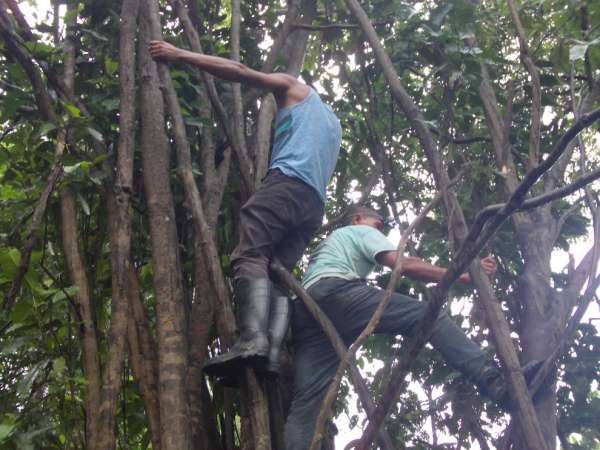
Egg
And it worked …

Grilled eggs
All we need is an egg, a narrow stick, a little dexterity with tapping both ends of the egg and we can grill …

Egg
Bury in the ashes and wait about 20 minutes and the food is ready …

Hunting
Tanzania's smallest national park
Hunting (rodents, fish or larger animals) is another way to get something in your stomach. It's a more energy-intensive way, but with a successful hunt we can take in far more calories than collecting. We can hunt with traps or make various primitive weapons. Trapping: The advantage of trapping is that we do not have to lurk somewhere for our „victim“ and can engage in other activities. There are many types of primitive traps, such as: footsteps, spikes, falling, wicker traps for fish, eyes, pits … Everyone will certainly find the construction of individual traps on the Internet, it is difficult to describe in words, instructional videos are better, for example on Youtube . However, I would like to dwell on traps a bit, in the way of laying and choosing a suitable place. When preparing traps, we pay attention to our smell, which the animals feel very well. We always try to prepare traps (pins, notches, eyes …) always outside the places where we want to make our trap afterwards. We can also partially eliminate our odor by rubbing our hands with some natural material (moss, needles, grass, clay, berries, mud …) before preparing the trap. We set traps in the places where animals most often go. We will definitely not miss the tracks that have been trodden in the forest … We try to tread on these trails as little as possible and not leave our smell there unnecessarily. After setting the trap, we can multiply our intention by directing the animal into our trap. The direction is made by inserting pointed pins into the ground in such a way that we create a kind of large funnel, which narrows towards the trap. The animal finds it easier to run along the pegs than to jump over them more difficultly and does not know that it is falling into a trap. We can also equip the traps with an audio device to let us know that a trap has been set. All we have to do is tie an empty can with a few stones to the moving part (cable, branch …), which will alert us with a rattling sound to the activation of the trap. We also check the traps, as the catch can perish quickly (especially in areas with higher temperatures and humidity), or it can be easy prey for another animal. If we are in the vicinity of rivers and water, a good option in an emergency is fishing. We can easily make a fish trap from wicker, where the result is a kind of wicker basket, which has a funnel that points inwards instead of a lid. The fish can easily get inside, but since the funnel is directed inwards, they will not find a way out. It is advisable to place a larger stone in this trap so that the trap goes to the bottom, otherwise it will swim and we will not catch many fish there. Let's not forget the tight mooring of this trap, it can easily be taken away by the current of the river … Hunting with primitive weapons: The production of primitive weapons such as bows and arrows or a spear is not difficult. The basis is flexible and at the same time solid wood (for example, ash in our country). When making a bow, we start by finding a straight branch with a diameter of about 8 to 10 cm, which we cut lengthwise. We will smooth the center (approx. 20 cm), for which we will then hold the bow itself. Then we narrow the rest of the bow to maintain the width of the bow and narrow only the inner part. This will achieve good flexibility. For the string we can use, for example, a bast made of willow braided into a rope, or also shoelaces or a parachute cord (if we have it on hand). It is a good idea to cook the bast for the string knitting water for about 10 minutes in charcoal water from the fireplace. It then becomes more resilient. Hazelnuts, for example, are excellent for arrows in our conditions. We choose rods as straight as possible. Any slight unevenness can be corrected by heating the rod over the fire and bending it into the desired (straight) shape. Cut the arrowhead (thicker end of the rod) to the tip and partially tan over the fire. This hardens the tip and makes it more durable. We can also use, for example, a suitable sharp, pointed stone (flint) on the tip of the arrow, bones adjusted to the tip, a small blade from a knife, or anything else that will do us the same service. We can also make a spear. The procedure is about the same as for making an arrow. We can also chop the tip of the spear crosswise to create four sharp points at the end of the spear, which can multiply the chances of success. We can also make Atlatl for the spear, which will multiply our strength when throwing a spear. It is actually a stick about a meter long, which has a hook made at one end, which fits exactly into the end of the spear. This spear throwing technique takes a bit of practice. When fishing with a spear, keep in mind the refraction of light by the water surface. If you see a fish swimming underwater and about to catch it with a spear or an arrow, always aim a little behind it. The water level distorts the light, and the deeper the fish, the more we have to aim for it.
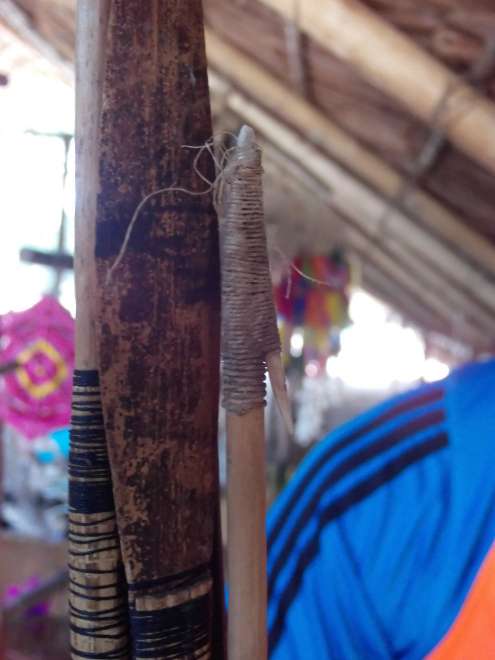
Detail of an arrowhead
Arrowhead made of bones and attached with the bast of a Babassu palm

Bow and arrows
A common weapon of the Amazon Indians
Fishing
Night fishing with a spear

Caiman hunting
Cayman caught us (eye)

Caiman
Catching a caiman is one thing, hitting him with a spear is another … However, hunger is hunger …
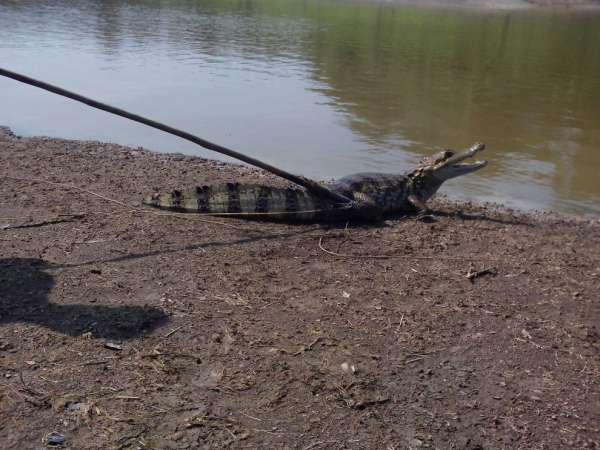
Catch
Tanzania's smallest national park
Safe handling of catches: Care should be taken when handling catches (especially warm-blooded animals). We never know what an animal can be infected with. After catching the animal, we first make sure that it shows no signs of any disease. It should have clear eyes, the coat should be free of visible caries (scratched bald spots, sores, etc.), and it should not have any festering wounds. Then we check our hands for injuries. We can easily infect raw meat into open wounds. Then it is advisable to put the caught animal in the fire and tan properly without any cooking, cutting, etc. So it stinks a lot, but together with fur, hair and claws we also burn all the parasites on the animal's body. Then we can gut the animal. Just remove everything you see inside. Also separate the head. It is also advisable to use some hand protection when handling raw meat. We probably won't have latex gloves with us (maybe in the first aid kit), but a plastic bag or a condom can help us as well. Also skin. Then wash the meat thoroughly in water and remove any clotted blood. The treated catch is already ready for heat treatment. Catch heat treatment: Always make sure that the meat is adequately heat treated. An animal can be infected with rabies, internal parasites, and God knows what else. You kill most with heat higher than 65 degrees Celsius. Even so, I prefer grilling over a fire to cooking in water. Boiling water is about 100 degrees Celsius, fire about 650 degrees Celsius. Do not consume the brain and intestines, they contain the largest number of internal parasites. We can use them, for example, as bait for the next hunt. Extending the shelf life of a catch: It can happen that the catch will be larger than we can eat in a day. In this case, we can either preserve raw meat with smoke, freeze it or dry it. Smoke preservation: Above a small fire, we create a roof from the ground from raw branches and leaves so that the smoke escapes us as little as possible and at the same time does not catch us from the fire. We hang the meat on the roof and smoke for several hours. This will significantly extend the shelf life of the meat. Drying meat: If we are in an environment where the sun is shining, we can let the meat dry in the sun. Cut the meat into as thin slices as possible so that it is dried as soon as possible. Drying will extend the shelf life. Before consumption, we soak the dried meat in water and heat-treat it. Freezing meat: It's easy. If we are in an area of snow and ice where it freezes, we will bury the meat in the snow. Here, however, we pay attention to other animals, they are also hungry and can sniff out and take our catch.
Caught armadillo
Prefer grilling over a fire before cooking in water.

Drying of caught fish
Always try to make the catch as thin as possible, you will significantly shorten the drying time.
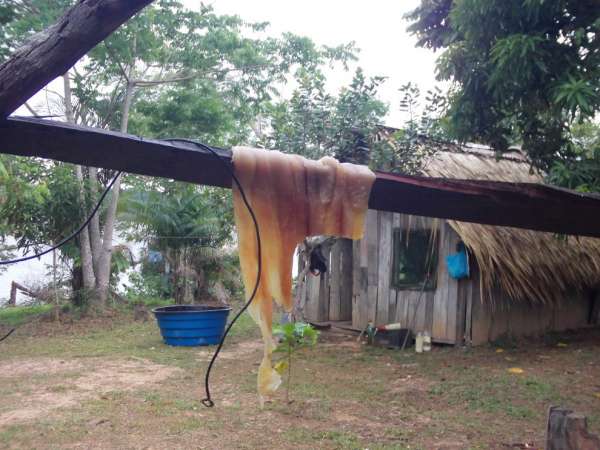
Cleaning of caught fish
Remove all scales, fins and everything inside.
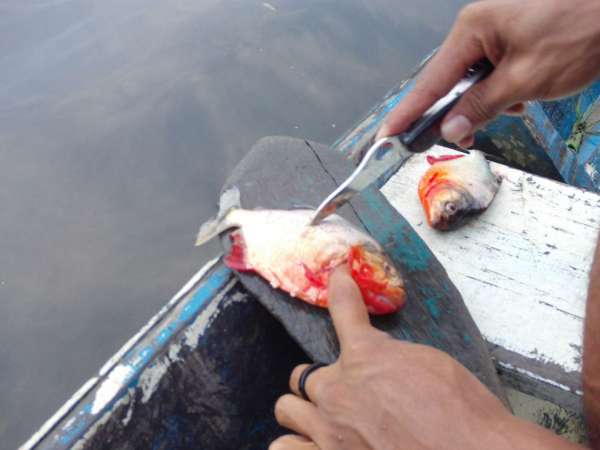
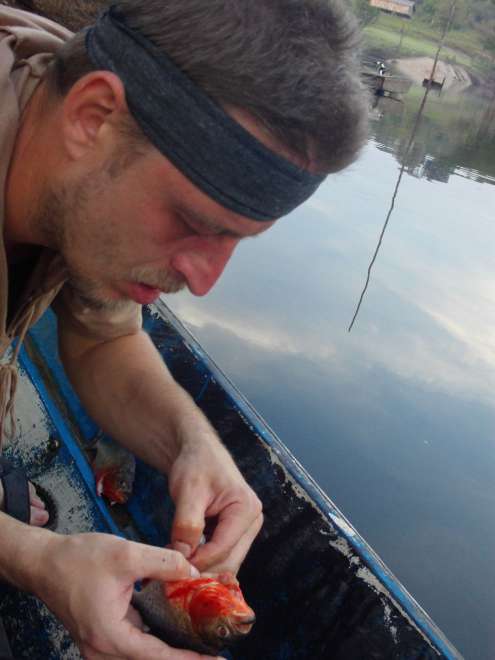
Caught piranha
Beware of injuries when handling. Even scratches on bone or sharp teeth can easily become inflamed.
Conclusion
Tanzania's smallest national park
I've been thinking for a long time about what to add in the end. One thing occurred to me: Nothing is as simple as it seems. If one gets into a situation where one really has to get something to eat in order to survive, one will certainly not feel like an adventurer and super chunk hunter, but rather like a castaway in a hopeless situation. It will not grow around anything edible, hunting may not always succeed and traps may remain empty … However, keep in mind that the human body will last without food for a few weeks. Again, it's just our psyche that tells us that we need to eat at least 2 to 3 times a day. Our body will last longer than we think … At the very end of this article, I would like to point out that hunting game, fish, etc. is prohibited in most countries without permission. I trust that you will use this information exclusively and only in emergency situations or where this activity is legal.






